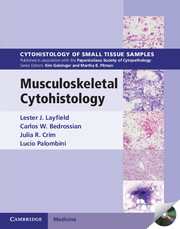Book contents
- Frontmatter
- Contents
- 1 Principles and practice for biopsy diagnosis and management of musculoskeletal lesions
- 2 Ancillary techniques useful in the evaluation and diagnosis of bone and soft tissue neoplasms
- 3 Spindle cell tumors of bone and soft tissue in infants and children
- 4 Spindle cell tumors of the musculoskeletal system characteristically occurring in adults
- 5 Giant cell tumors of the musculoskeletal system
- 6 Myxoid lesions of bone and soft tissue
- 7 Lipomatous tumors
- 8 Vascular tumors of bone and soft tissue
- 9 Pleomorphic sarcomas of bone and soft tissue
- 10 Osseous tumors of bone and soft tissue
- 11 Cartilaginous neoplasms of bone and soft tissue
- 12 Small round cell neoplasms of bone and soft tissue
- 13 Epithelioid and polygonal cell tumors of bone and soft tissue
- 14 Cystic lesions of bone and soft tissue
- Index
7 - Lipomatous tumors
Published online by Cambridge University Press: 05 September 2013
- Frontmatter
- Contents
- 1 Principles and practice for biopsy diagnosis and management of musculoskeletal lesions
- 2 Ancillary techniques useful in the evaluation and diagnosis of bone and soft tissue neoplasms
- 3 Spindle cell tumors of bone and soft tissue in infants and children
- 4 Spindle cell tumors of the musculoskeletal system characteristically occurring in adults
- 5 Giant cell tumors of the musculoskeletal system
- 6 Myxoid lesions of bone and soft tissue
- 7 Lipomatous tumors
- 8 Vascular tumors of bone and soft tissue
- 9 Pleomorphic sarcomas of bone and soft tissue
- 10 Osseous tumors of bone and soft tissue
- 11 Cartilaginous neoplasms of bone and soft tissue
- 12 Small round cell neoplasms of bone and soft tissue
- 13 Epithelioid and polygonal cell tumors of bone and soft tissue
- 14 Cystic lesions of bone and soft tissue
- Index
Summary
INTRODUCTION
Neoplasms showing lipomatous differentiation comprise the numerically largest family of neoplasms in man. They can occur at almost all body sites and display a wide age spectrum ranging from infancy to late adult life. Benign lipomas are most frequent in patients between 40 and 60 years of age while liposarcomas most often come to clinical attention in patients over 50 years of age.
Neoplasms showing true lipomatous differentiation express S-100 protein. Additionally, benign lipomatous neoplasms display a variety of translocations, rearrangements, and other genetic alterations which include translocations involving 12q13–15, 8q11–13, 11q13, and 10q22. Lipomas of usual type show deletions of 13q, while spindle cell and pleomorphic lipomas show loss of 16q13.
Of diagnostic importance is the CHOP gene rearrangement characteristic of myxoid and round cell liposarcomas and amplification of the MDM2 gene in well differentiated liposarcomas and atypical lipomatous neoplasms. This gene amplification helps distinguish these neoplasms from benign lipomas.
LIPOMA
Clinical features
Lipomas occur as both solitary and multiple lesions. Most are removed for cosmetic purposes. Lipomas are rare before 20 years of age but gradually increase in frequency with a maximum prevalence in patients 40 to 60 years old. The frequency of lipomas does not vary with race. Men appear to be more frequently affected.
Lipomas may occur as either superficial or deep neoplasms and, in both locations, are usually asymptomatic slowly growing masses. Pain is rarely apparent in ordinary lipomas, but angiolipomas are often painful. Imaging studies are helpful in identifying a lesion as fatty in nature but are of less aid in separating benign from malignant neoplasms. Magnetic resonance imaging studies of both benign and malignant lipomatous neoplasms demonstrate high signal intensity on T1-weighted images.
- Type
- Chapter
- Information
- Musculoskeletal Cytohistology , pp. 140 - 164Publisher: Cambridge University PressPrint publication year: 2000



